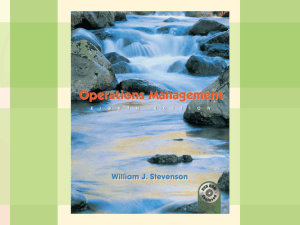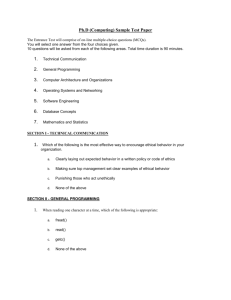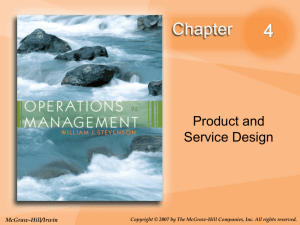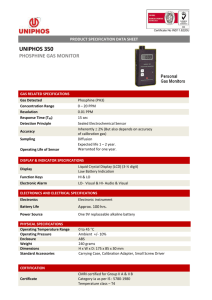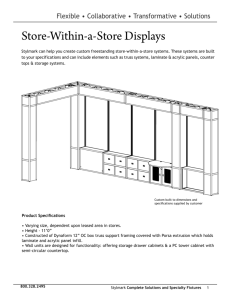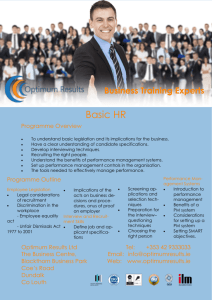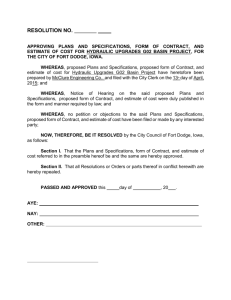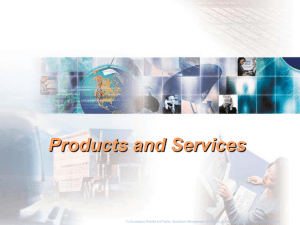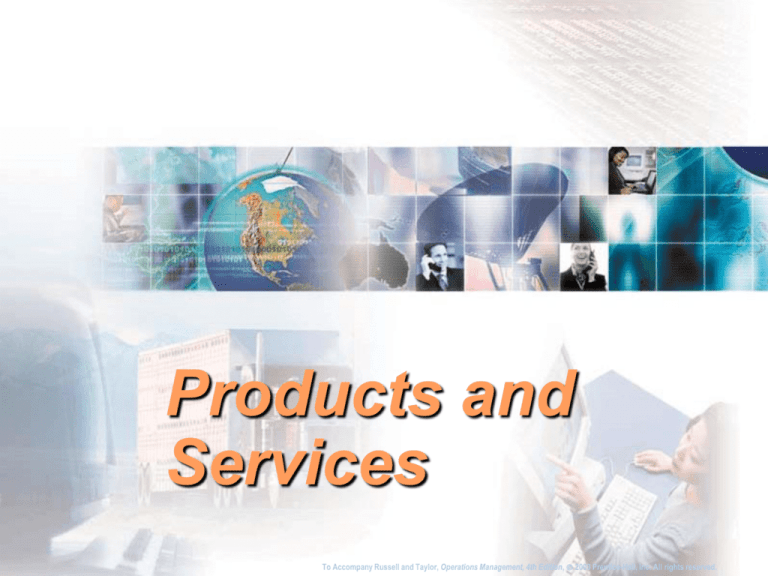
Products and
Services
To Accompany Russell and Taylor, Operations Management, 4th Edition, 2003 Prentice-Hall, Inc. All rights reserved.
Design of Products
Humor in Product Design
As the customer
wanted it.
© 1984-1994 T/Maker Co.
As Operations made it.
© 1984-1994 T/Maker Co.
As Marketing
interpreted it.
© 1984-1994 T/Maker Co.
As Engineering
designed it.
© 1984-1994 T/Maker Co.
What is a Product?
• Need-satisfying offering of an
organization
–Example
• P&G does not sell laundry
detergent
• P&G sells the benefit of clean
clothes
• Customers buy satisfaction, not parts
• May be a good or a service
Product and Service Design
Major factors in design strategy
•Cost
•Quality
•Time-to-market
•Customer satisfaction
•Competitive advantage
Product and service design – or redesign – should be
closely tied to an organization’s strategy
Product or Service Design
Activities
• Translate customer wants and needs
into product and service requirements
• Refine existing products and services
• Develop new products and services
• Formulate quality goals
• Formulate cost targets
• Construct and test prototypes
• Document specifications
Product Life Cycle, Sales,
Cost, and Profit
Sales, Cost & Profit .
Cost of
Development
& Manufacture
Sales Revenue
Profit
Cash flow
Loss
Time
Introduction
Growth
Maturity
Decline
Products in Various Stages of
Life Cycle
Sales
Growth
Introduction
CD-ROM
Internet
Maturity
Decline
Jet Ski, fax machines
Boeing
727
3½
Floppy
disks
Flatscreen
monitors
Time
Degree of Newness of a
Product/Service
1.Modification of an existing product/service
2.Expansion of an existing product/service
3.Clone of a competitor’s product/service
4.New product/service
Degree of Design Change
Type of Design
Change
Newness of the
organization
Newness to the
market
Modification
Low
Low
Expansion
Low
Low
Clone
High
Low
New
High
High
Trends in Product & Service
Design (1 of 2)
Increased emphasis on or attention to:
Customer satisfaction (by translating
customer wants and needs into product and
service requirements)
Reducing time to introduce new product or
service
Reducing time to produce product
Trends in Product & Service
Design (2 of 2)
Increased emphasis on or attention to:
The organization’s capabilities to produce or
deliver the item
Refining existing products and services
Environmental concerns
Designing products & services that are “user
friendly”
Designing products that use less material
Why Companies Design New
Products and Services
To be competitive
To increase business growth and profits
To avoid downsizing with development
of new products
To improve product quality
To achieve cost reductions in labor or
materials
Main Reasons for Product or Service
Design
• Economic
• Social and demographic
• Political, liabili
• Cost or availability
• Competitive
• Technological
Objectives of Product and
Service Design
• Main focus
–Customer satisfaction
• Secondary focus
–Function of product/service
–Cost/profit
–Quality
–Appearance
–Ease of production/assembly
–Ease of maintenance/service
An Effective Design Process
Matches product/service characteristics
with customer needs
Meets customer requirements in the
simplest, most cost-effective manner
Reduces time to market
Minimizes revisions
Few Successes
2000
1500
1000
500
0
Number of
Ideas
1750
Design review,
Testing, Introduction
Market
requirement
1000
Functional
specifications
500
Product
specification
100
Development Stage
25
One
success!
Stages in the
Design Process
1. Idea Generation — Product
Concept
2. Feasibility Study — Performance
Specifications
3. Preliminary Design — Prototype
4. Final Design — Final Design
Specifications
5. Process Planning — Manufacturing
Specifications
The Design Process
Idea
generation
Suppliers
Product or
service concept
Feasibility
study
Performance
specifications
Form design
Customers
R&D
Marketing
Competitors
Revising and testing
prototypes
Production
design
Functional
design
New product or
service launch
Final design
& process plans
Design
specifications
Pilot run
and final tests
Manufacturing
or delivery
specifications
Step 1: Idea Generation
Suppliers, distributors, salespersons,
competitors
Trade journals and other published
material
Warranty claims, customer
complaints, failures
Customer surveys, focus
groups, interviews
Field testing, trial users
Research and development
Research & Development (R&D)
• Organized efforts to increase scientific
knowledge or product innovation & may involve:
Basic Research advances knowledge about a
subject without near-term expectations of
commercial applications.
Applied Research achieves commercial
applications.
Development converts results of applied
research into commercial applications.
More Idea Generators
Perceptual Maps
Visual comparison of
customer perceptions
Benchmarking
Comparing product/service
against best-in-class
Reverse engineering
Dismantling and inspecting a competitor’s
product to discover product improvements
Perceptual Map of Breakfast
Cereals (1 of 2)
GOOD
TASTE
LOW
NUTRITION
HIGH
NUTRITION
BAD
TASTE
Perceptual Map of Breakfast
Cereals (2 of 2)
GOOD
TASTE
Cocoa Puffs
LOW
NUTRITION
HIGH
NUTRITION
Rice
Krispies
Cheerios
Wheaties
Shredded
Wheat
BAD
TASTE
Step 2: Feasibility Study
Market
Analysis
Economic
Analysis
Technical / Strategic Analysis
Performance Specifications are written
for product concepts that pass the
feasibility study
Step 3: Preliminary Design
Create form & functional design
Build prototype
Test prototype
Revise prototype
Retest
3.1. Form Design
(How the Product Looks)
Cellular Personal
Safety Alarm
Personal Computer
3.2. Functional Design
(How the Product Performs)
Reliability: The ability of a product, part or system to
perform its intended function under a prescribed set of
conditions over a specified length of time. It is
expressed as the probability that the product performs
intended function for a specified length of time
Normal Operating Conditions: the set of conditions
under which an item’s reliability is specified
Maintainability: Ease and/or cost of maintaining/
repairing product
How to improve Reliability
Component design
Production/assembly techniques
Testing
Redundancy/backup
Preventive maintenance procedures
User education
System design
3.3. Production Design
Part of the preliminary design phase
Simplification
Standardization
Mass customization
3.3.1. Design Simplification (1 of 3)
(a) The original design
Assembly using
common fasteners
3.3.1. Design Simplification (2 of 3)
(a) The original design
Assembly using
common fasteners
(b) Revised design
One-piece base &
elimination of
fasteners
3.3.1. Design Simplification (3 of 3)
(a) The original design
Assembly using
common fasteners
(b) Revised design
(c) Final design
One-piece base &
elimination of
fasteners
Design for
push-and-snap
assembly
3.3.2. Standardization
Standardization
Extent to which there is absence of variety in
a product, service or process
Standardized products are immediately
available to customers
Advantages of Standardization
(1 of 2)
• Fewer parts to deal with in inventory &
manufacturing
• Design costs are generally lower
• Reduced training costs and time
• More routine purchasing, handling, and
inspection procedures
Advantages of Standardization
(2 of 2)
• Orders fillable from inventory
• Opportunities for long production runs and
automation
• Need for fewer parts justifies increased
expenditures on perfecting designs and
improving quality control procedures.
Disadvantages of Standardization
• Designs may be frozen with too many
imperfections remaining.
• High cost of design changes increases
resistance to improvements.
• Decreased variety results in less consumer
appeal.
3.3.3. Mass Customization
Mass customization: A strategy of
producing basically standardized goods or
services, but incorporating some degree of
customization by:
– Delayed differentiation
– Modular design
3.3.3.1. Delayed Differentiation
Delayed differentiation is a
postponement tactic
Producing but not quite completing a
product or service until customer
preferences or specifications are
known
3.3.3.2. Modular Design
Modular design is a form of standardization in which
component parts are subdivided into modules that
are easily replaced or interchanged. It allows:
–
easier diagnosis and remedy of failures
–
easier repair and replacement
–
simplification of manufacturing and assembly
And it adds flexibility to both production and
marketing
Steps 4&5: Final Design &
Process Plans
Produce detailed drawings &
specifications
Create workable instructions for
manufacture
Select tooling & equipment
Prepare job descriptions
Determine operation & assembly order
Program automated machines
Improving the Design Process
Design teams & concurrent design
Design for manufacture & assembly
Design for disassembly
Design to prevent failures and ensure value
Design for environment
Measure design quality
Utilize quality function deployment
Utilize Computer Aided Design
Design for robustness
Engage in collaborative design
Organizing for Product
Development (1 of 2)
• Historically – distinct departments
– Duties and responsibilities are defined
– Difficult to foster forward thinking
• Today – team approach
– Representatives from all disciplines or
functions
– Concurrent engineering – cross functional
team
Organizing for Product
Development (2 of 2)
• Traditional Approach
– “We design it, you build it” or “Over the
wall”
• Concurrent Engineering
– “Let’s work together simultaneously”
“Over the Wall” Approach
New
Product
Mfg
Design
Breaking Down Barriers to Effective
Design
Design Teams
Marketing, manufacturing,
engineering
Suppliers, dealers, customers
Lawyers, accountants,
insurance companies
Concurrent Engineering
Defined
Concurrent engineering is the bringing together of
personnel from various functions together early in the
design phase.
CE can be defined as the simultaneous development
of project design functions, with open and interactive
communication existing among all team members for
the purposes of reducing time to market, decreasing
cost, and improving quality and reliability
Time savings are created by performing activities in
parallel
Concurrent Design
Improves quality of early design
decisions
Scheduling and management can be
complex as tasks are done in parallel
Design for
Manufacture and Assembly
Design a product for easy
& economical production
Incorporate production
design early in the design phase
Taking into account the manufacturing capabilities of
the organization in designing goods
The more general term “design for operations”
encompasses services as well as manufacturing
Improves quality, productivity and reduces costs
Shortens time to design and manufacture
DFM Guidelines
1. Simplify products by reducing the number of
separate parts
2. Minimize the number of parts, tools, fasteners,
and assemblies
3. Use standard parts and repeatable processes
4. Design parts for many uses
5. Incorporate modularity in design
6. Design for ease of assembly, minimal handling
7. Allow for efficient testing and parts replacement
Design for Assembly (DFA)
Procedure for reducing the
number of parts
Evaluate methods for
assembly
Determine the
sequence of assembly
operations
Design for Disassembly
Designing products so that they can be
more easily taken apart.
Includes fewer parts and less material
and using snap-fits where possible
instead of screws or nuts and bolts
Value Analysis/Value Engineering
(VA/VE) ( 1 of 4)
Achieve equivalent or better performance at
a lower cost while maintaining all functional
requirements defined by the customer
Ratio of value / cost
Value analysis focuses on design
improvements during production
Value Analysis/Value Engineering
(2 of 4)
Assessment of value :
1. Can we do without it?
2. Does it do more than is required
3. Does it cost more than it is worth?
4. Can something else do a better job
5. Can it be made by less costly method, tools,
material?
6. Can it be made cheaper, better or faster by
someone else?
7. Does the item have any design features that are
not necessary?
8. Can two or more parts be combined into one?
Benefits of VA/VE (3 of 4)
• Benefits:
simplified products
additional standardization of products
improved functional aspects of product
improved job design and job safety
improved maintainability of the product
robust design
Cost Reduction of a Bracket
via Value Engineering (4 of 4)
Design for Environment
Design safe and environmentally
sound (eg. recyclable) products
Design from recycled material
Use materials which can be recycled
Design for ease of repair
Minimize packaging
Minimize material & energy
used during manufacture,
consumption & disposal
Recycling: Recovering materials for future use
“Green Manufacturing”
•
•
•
•
•
•
Make products recyclable
Use recycled materials
Use less harmful ingredients
Use lighter components
Use less energy
Use less material
Design for
Environment
Quality Function Deployment
(QFD)
QFD is an approach that integrates the “voice
of the customer” into the product and service
development process. Translates customer
preferences into specific product characteristics
Enables to design for the customer
Displays requirements in matrix diagrams
First matrix called “house of quality”
Series of connected houses
Quality Function Deployment
Process
Identify customer wants
Identify how the good/service will satisfy
customer wants
Relate customer wants to product hows
Identify relationships between the firm’s
hows
Develop importance ratings
Evaluate competing products
Importance
House of Quality
5
Correlation matrix
3
Design
requirements
1
4
2
Customer
requirements
Relationship
matrix
Competitive
assessment
6
Target values
House of Quality Example
Correlation:
X
X
Water resistance
Accoust. Trans.
Window
Check force
on level
ground
Energy needed
to open door
Door seal
resistance
Energy needed
to close door
Engineering
Characteristics
X
X
X
X
*
Strong positive
Positive
Negative
Strong negative
Competitive evaluation
X = Us
A = Comp. A
B = Comp. B
(5 is best)
1 2 3 4
Customer
Requirements
Easy to close
7
X
Stays open on a hill
5
X AB
Easy to open
3
Doesn’t leak in rain
3
No road noise
Importance weighting
2
XAB
A XB
X
BA
X
9
Reduce energy
to 7.5 ft/lb.
B
A
X
B
X
A
2
3
Maintain
current level
B
A
6
Maintain
current level
5
4
3
2
1
6
Maintain
current level
Reduce energy
level to 7.5 ft/lb
10
Reduce force
to 9 lb.
X A
Target values
Technical evaluation
(5 is best)
5
AB
BXA
BA
X
Relationships:
Strong = 9
Medium = 3
Small = 1
B
Customer
requirements
information
forms the
basis for this
matrix, used
to translate
them into
operating or
engineering
goals.
Technology in Design:
Computer Aided Design
(CAD)
• Designing products at
a computer terminal
or work station
– Design engineer
develops rough
sketch of product
– Uses computer to
draw product
• Often used with CAM
© 1995 Corel Corp.
Benefits of CAD
Produces better designs faster
Builds database of designs and creates
documentation to support them
Shortens time to market
Reduces time to manufacture
Enlarges design possibilities
Enhances communication and promotes
innovation in design teams
Provides possibility of engineering and cost
analysis on proposed designs
Design for Robustness
Product can fail due to poor design quality
Products subjected to many conditions
Robust Design results in products or services that
can function over a broad range of conditions
A robust product is to be designed that is insensitive
to environmental factors either in manufacturing or in
use
Robust design studies
• Controllable factors - under designer’s control
• Uncontrollable factors - from user or environment
Design products for consistent performance
Consistency is Important
Consistent errors are easier to correct
than random errors
Parts within tolerances
may yield assemblies
which aren’t
Consumers prefer
product characteristics
near their ideal values
Remanufacturing
Refurbishing used products by replacing worn
out or defective components and reselling the
products.
Reverse Engineering
Reverse engineering is the dismantling and
inspecting of a competitor’s product to discover
product improvements.
The Kano Model
Customer Satisfaction
Kano Model
Excitement
Expected
Must Have
Customer Needs
Global Product Design
Virtual teams
Uses combined efforts of a team of designers
working in different countries
Provides a range of comparative advantages
over traditional teams such as:
Engaging the best human resources around the world
Possibly operating on a 24-hr basis
Global customer needs assessment
Global design can increase marketability
Design Guidelines (1 of 2)
Produce designs that are consistent with the goals
of the company
Take into account the operations capabilities of the
organization in order to achieve designs that fit with
those capabilities
Take into account the cultural differences related to
product design (for multinationals)
Give customers the value they expect
Make health and safety a primary concern
Consider potential harm to the environment
Design Quidelines (2 of 2)
• Increased emphasis on components
commonality
• Package products and services
• Use multiple-use platforms
• Consider tactics fodr mass customization
• Look for continual improvement
• Shorten time to market
Design of Services
Characteristics of Services
(1 of 2)
1. Services are acts, they are intangible but
highly visible to the customers
2. Services are idiosyncratic
3. Services are created and delivered at the
same time and are not consumed but
experienced, cannot be inventoried.
4. Service requirements are variable
5. Service have customer contact
6. Services are perishable
Characteristics of Services
(2 of 2)
7. Services have low barriers to entry
8. Location is yimportant for service
9. Service inseparable from delivery
1. Tend to be decentralized and dispersed
2. Consumed more often than products
3. Services can be easily emulated
Service Businesses
Defined
A service business is the management of
organizations whose primary business
requires interaction with the customer to
produce the service
• Facilities-based services: Where the customer
must go to the service facility
• Field-based services: Where the production and
consumption of the service takes place in the
customer’s environment
Internal Services
Defined
Internal services is the
management of services
required to support the
activities of the larger
organization. Services
including data processing,
accounting, etc
Internal Supplier
Internal
Customer
External
Customer
Internal Supplier
Differences Between Product
and Service Design (1 of 2)
Service design often focuses more on
intangible factors
Less latitude in finding and correcting errors
before the customer, so training & process
design are important
As services are noninventoriable, capacity
issues are very important
Differences Between Product
and Service Design (2 of 2)
Services are highly visible to consumers and
must be designed with that in mind
Some services have low barriers to entry and
exit, so service design has to be innovative
and cost-effective
As convenience is a major factor, location is
important to service design
Service design with high customer contact
generally requires inclusion of the service
delivery package
Service Delivery System
Components of service delivery system:
Facilities
Processes
Skills
Service Design
• Service design involves
– The physical resources needed
– The goods that are purchased or
consumed by the customer
– Explicit services
– Implicit services
Service Demand Variability
Demand variability creates waiting lines and
idle service resources
Service design perspectives:
Cost and efficiency perspective
Customer perspective
Customer participation makes quality and
demand variability hard to manage
Attempts to achieve high efficiency may
depersonalize service and change
customer’s perception of quality
Phases in Service Design
• Determine performance specifications
• Translate performance specifications
into design specifications
• Translate design specifications into
delivery specifications
Service Systems
• Service systems range from those with little or no
customer contact to very high degree of customer
contact such as:
– Insulated technical core (software development)
– Production line (automatic car wash)
– Personalized service (hair cut, medical service)
– Consumer participation (diet program)
– Self service (supermarket)
Service-System Design Matrix
Degree of customer/server contact
High
Buffered
core (none)
Permeable
system (some)
Reactive
system (much)
Low
Face-to-face
total
customization
Face-to-face
loose specs
Sales
Opportunity
Face-to-face
tight specs
Internet &
on-site
Mail contact technology
Low
Production
Efficiency
Phone
Contact
High
Phases in Service Design
1.Conceptualize
2.Identify service package components
3.Determine performance specifications
4.Translate performance specifications into
design specifications
5.Translate design specifications into
delivery specifications
Service Blueprinting
Service blueprinting
A method used in service design to describe
and analyze a proposed service
A useful tool for conceptualizing a service
delivery system
Major Steps in Service
Blueprinting
1. Establish boundaries
2. Identify sequence of customer
interactions
•
Prepare a flowchart
3. Develop time estimates
4. Identify potential failure points
Example of Service Blueprinting
Standard
execution time
2 minutes
Brush
shoes
30
secs
Total acceptable
execution time
5 minutes
Seen by
customer
Line of
visibility
Not seen by
customer but
necessary to
performance
Clean
shoes
45
secs
Apply
polish
30
secs
Fail
point
Buff
Collect
payment
45
secs
15
secs
Wrong
color wax
Materials
(e.g., polish, cloth)
Select and
purchase
supplies
Service Fail-safing
Poka-Yokes (A Proactive Approach)
• Keeping a
mistake from
becoming a
service defect
Task
Treatment
• How can we failsafe the three
Ts?
Tangibles
Have we
compromised
one of the
3 Ts?
1. Task
2. Treatment
3. Tangible
Characteristics of a WellDesigned Service System (1 of 2)
1. Each element of the service system is
consistent with the operating focus of the firm
2. It is user-friendly
3. It is robust and easy to sustain
4. It is structured so that consistent performance
by its people and systems is easily maintained
Characteristics of a Well-Designed
Service System (2 of 2)
5. It provides effective links between the back
office and the front office so that nothing falls
between the cracks
6. It manages the evidence of service quality in
such a way that customers see the value of the
service provided
7. It is cost-effective
8. It ensures reliability and high quality
Challenges of Service Design
1.
2.
3.
4.
Variable requirements
Difficult to describe
High customer contact
Service – customer encounter
Guidelines for Successful
Service Design
1.
2.
3.
4.
5.
6.
7.
8.
9.
Define the service package
Focus on customer’s perspective
Consider image of the service package
Recognize that designer’s perspective is different
from the customer’s perspecticve
Make sure that managers are involved
Define quality for tangible and intangibles
Make sure that recruitment, training and rewards are
consistent with service expectations
Establish procedures to handle exceptions
Establish systems to monitor service


